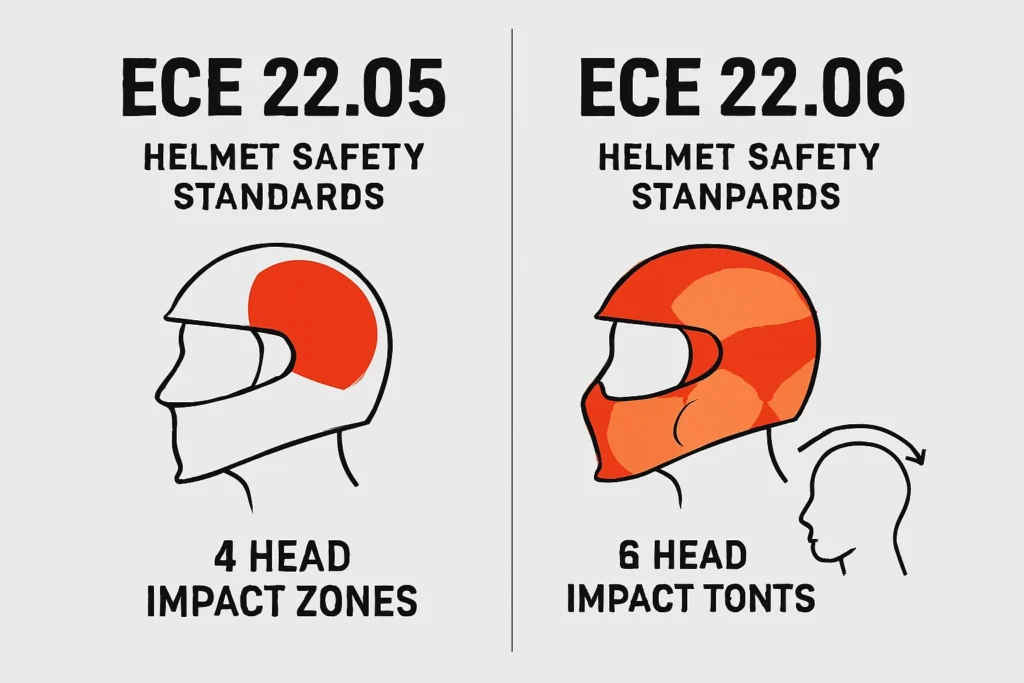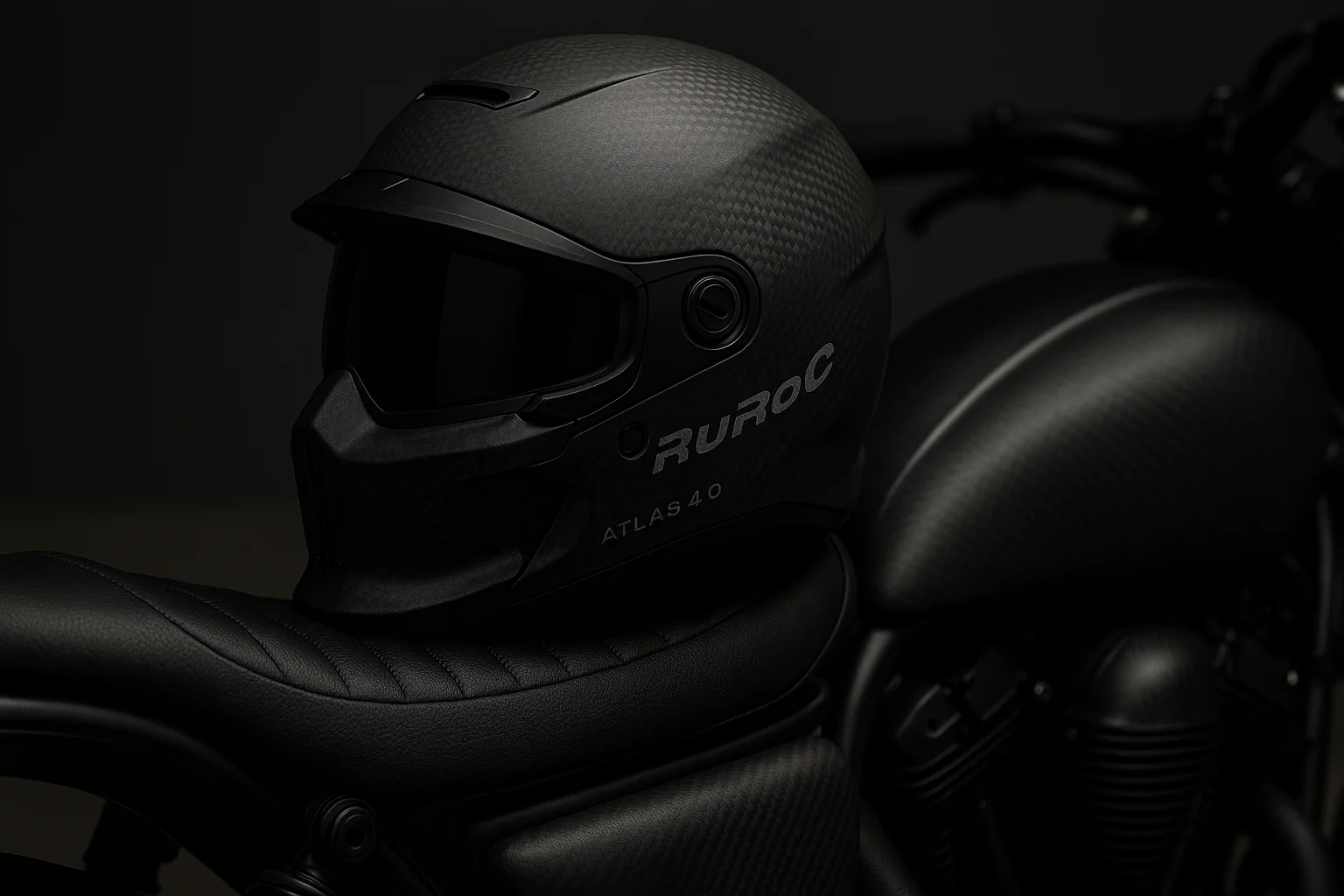I’ll be honest, when I first saw Ruroc helmets online, I was hooked. The sharp lines, aggressive streetfighter design, and that raw carbon finish made me want one before I even knew anything about its features. But just like you, I asked myself: Is Ruroc a good brand, or just another hyped product from social media influencers?
That question led me down the road of buying and testing the Ruroc Atlas 4.0 helmet myself, and now, after months of use across multiple bikes, I’m here to give you the real picture in plain, easy-to-understand language.
Whether you’re new to riding or a seasoned biker looking to upgrade, this blog is my full experience with Ruroc’s most advanced helmet yet, its strengths, its letdowns, and everything in between. If you’re considering investing in the Ruroc Atlas 4.0, read this first. Still deciding between modular and full-face? Discover which one offers the protection you really need in Are Modular Helmets as Safe as Full Face?
What First Caught My Eye: The Design
The Ruroc Atlas 4.0 is a head-turner. Designed in the UK, this helmet doesn’t look like anything else on the road. It reminded me of those iconic Simpson Bandits that were all the rage in the ’90s, but this one is fully legal and ECE 22.06 certified.

That’s a big deal. Most helmets you see in shops still meet the older 22.05 safety standard, but the 22.06 version is tougher. It tests for 12 different impact zones and even checks how well the helmet protects your head from rotational forces during an accident.
In simple terms, this is one of the safest helmets you can legally wear on the road today. That was a major selling point for me, especially when thinking about real-world crashes, not just lab tests. Not sure what a modular helmet actually is? Get the complete breakdown in simple terms right here: What Is a Modular Motorcycle Helmet.
The Carbon Fiber Shell: Looks Cool, But Comes at a Cost
I went with the Raw Carbon version, which cost me around £475. You can get solid colors for cheaper, starting at £375. The carbon fiber looks amazing, and you’ll feel like a superhero putting it on. The texture, the matte finish, even the seam placement, it’s all beautifully done.
However, carbon fiber isn’t just about aesthetics. It’s also about strength and weight. Ruroc claims the helmet weighs around 1,600 grams, but mine came in at 1,713g on my kitchen scale. It’s heavier than other premium helmets like the Arai Quantic or Shoei NXR2, but honestly, I didn’t feel the extra weight once I was riding. What mattered more to me was wind drag, and in that department, the Ruroc performed well. No annoying head pull at high speeds.
Ventilation: Looks Good, Works Poorly
If you ride in hot weather or wear glasses like I do, ventilation is a big deal. Sadly, the Ruroc Atlas 4.0 let me down here. The helmet has a few vents, two on the chin, two on top, and two exhausts at the back, but they don’t do much.
The chin vent, which you can only adjust from inside the helmet, barely makes a difference. It also doesn’t push air up across the visor, which led to my glasses fogging up often in colder weather. The top vents are tiny, and I couldn’t feel any airflow whether they were open or closed.
Honestly, I’ve had cheaper helmets that ventilate better than this one. If airflow is a top priority for you, this might not be the right fit. Ready to upgrade your riding gear? Find out exactly Where to Get a Motorcycle Helmet that fits your style, budget, and safety needs.
Visor Performance and Pinlock Woes
The visor looks great and gives a wide field of view, though the raised nose section is noticeable. What annoyed me was the distortion at the bottom edge of the visor when it cracked open. It gets in your line of sight and can be distracting.
Another downside is the lack of a Pinlock insert in the box. You have to buy the Pinlock 70 separately for £25. Fogging can become an issue without it, especially during winter rides.
Swapping the visor for the included dark tint one? Not as easy as it should be. Ruroc uses a special latch system and a small tool that’s easy to lose. Compared to other brands where you can just pop the visor off in seconds, this felt unnecessarily complicated.
Interior Lining and Emergency Features
Inside, the helmet feels premium. The cheek pads are multi-layered for a snug fit, and they include pull-tabs that can help emergency responders safely remove your helmet after a crash. That kind of attention to safety detail is rare and appreciated.
The lining also has Rheon strips, a high-tech material that’s designed to absorb rotational impact forces. It’s part of the reason this helmet got its ECE 22.06 rating. Everything inside is removable, so you can wash it easily after long rides.
But here’s a weird issue I noticed: when taking the helmet off, the internal EPS foam shell moved slightly and exposed a bit of the inner lining. It didn’t feel dangerous, but it didn’t inspire confidence either. It makes the helmet feel less refined than others in its price range.
Strap System: Innovative, But Not Practical
Ruroc uses something called a Fidlock magnetic chin strap. Instead of threading a strap through a D-ring or using a ratchet, the two ends just snap together. Sounds futuristic, right?
In reality, it’s fiddly. You have to pre-set the strap length, and adjusting it afterward is annoying. I prefer micrometric or D-ring systems because they automatically adjust to your head each time you wear them. This one feels like a step backward. It’s secure, yes, but not user-friendly.
Fit and Sizing: Know Before You Buy
My first helmet size was wrong. I ordered a Small-Medium, but I couldn’t get it past my forehead. I exchanged it for a Medium-Large, which fit better. Ruroc offers a 14-day return policy, so at least there’s room to correct mistakes.
On long rides, I noticed a bit of pressure around the back of my head, close to the neck. It wasn’t unbearable, but it did become noticeable after an hour or two. So my advice is: always try it on before committing. Comfort becomes a big deal on longer journeys.
Noise Levels: Nothing Special
Let’s be real. Every helmet gets loud over 40 mph. That’s why I always wear earplugs. The Ruroc isn’t louder than most helmets I’ve tried, but it’s not whisper-quiet either. You won’t feel like you’re in a soundproof bubble. Just treat it like any other lid in this price range and use proper ear protection.
Bluetooth: Shockwave Sounds Great, But Isn’t
One of the things that excited me was the optional Shockwave Bluetooth system. It costs an extra £150 and fits snugly into the back of the helmet. It has a mic and speakers, connects via Bluetooth, and charges with a USB-C cable. Sounds solid, right?
Sadly, the reality doesn’t match the promise.
The buttons are small and placed awkwardly at the back of the helmet. It’s hard to find them while riding. Music controls barely worked with my Android phone, and the play/pause button didn’t respond at all.
The unit doesn’t have FM radio, and the Chain app that Ruroc pushes as its communication system was completely unusable during my test. Other riders reported the same problems on iOS. You’re better off skipping this upgrade and using a third-party intercom system, if it fits.
The Final Verdict: Is Ruroc a Good Brand?
Here’s the honest truth: I wanted to love this helmet. I really did. It looks fantastic, has cutting-edge safety certification, and comes with unique style you won’t find elsewhere. But after months of riding with it, I can’t say it’s the best choice for most bikers.
If you’re after style and are okay with sacrificing comfort and ease-of-use, the Ruroc Atlas 4.0 might be for you. It’s certainly one of the coolest-looking helmets out there, and it’ll protect your head in a crash. But if you value things like smooth ventilation, visor convenience, or Bluetooth reliability, you’ll find better options from more established brands.
Would I Recommend It?
For short commutes or style-focused riders: yes, especially if you love the look. For long-distance touring, daily riding, or Bluetooth-heavy users: not really.
There are better all-round helmets out there, even in the same price range. But if Ruroc keeps improving, especially with the next generation, they could truly become a top-tier brand.
As for me? I’ll keep it in my gear closet for short weekend rides, but for touring or city traffic, I’ll stick with my Shoei.
So, is Ruroc a good brand? They’re getting there. But for now, they still feel more like a fashion-forward newcomer than a fully matured motorcycle gear brand. Thinking of buying a Voss helmet? Don’t hit the road before you read this honest review: Are Voss Helmets Good?





